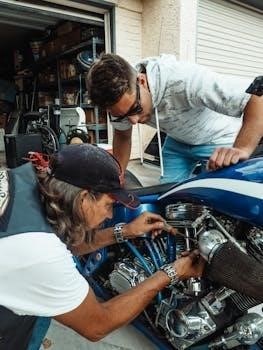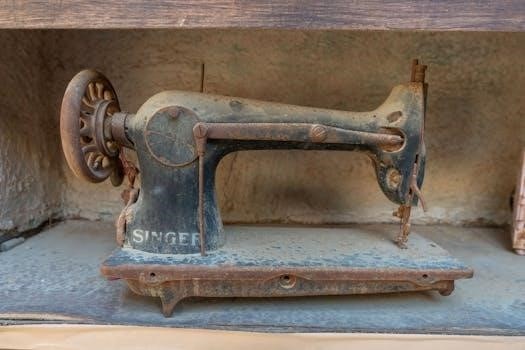The Singer 401A is a vintage sewing machine known for its slant needle design and robust functionality. This model offers a range of sewing capabilities, making it a favorite among sewing enthusiasts. The manual is essential to understand its operations.
Overview of the Singer 401A Model
The Singer 401A sewing machine, often referred to as the “Slant-o-Matic,” is a notable model in Singer’s history. It boasts a unique slant needle design, which enhances visibility and sewing precision. This machine is designed for various sewing tasks, including straight stitching, zigzag stitching, and decorative stitching. It’s a gear-driven machine known for its smooth and reliable performance, avoiding the common slipping or stalling issues of some other models. The 401A features a robust construction and a user-friendly interface, making it suitable for both beginners and experienced sewers. Its automatic capabilities and versatile functionality have made it a highly sought-after machine by vintage sewing machine enthusiasts. The machine’s design also includes a variety of stitch options and settings, allowing for a wide range of creative projects. The original manual is a crucial resource for utilizing the full potential of this model.

Availability of the Singer 401A Instruction Manual
Locating a Singer 401A instruction manual is crucial for users. These manuals are available through various sources, both digitally and in physical formats, aiding in the effective use of this machine.
Sources for Downloadable PDF Manuals
Numerous websites offer downloadable PDF versions of the Singer 401A instruction manual, catering to the needs of vintage sewing machine users. These digital manuals are often free and provide a convenient way to access the necessary information. Websites specializing in vintage sewing machines and manuals frequently host these resources, making them readily available to the public. Online libraries and digital archives also serve as valuable sources for finding these documents. Some manufacturers sites, though not always directly, might link to third-party resources that have these manuals available for download. It’s crucial to ensure that the source is reliable to avoid corrupted or incomplete files when downloading the manual. The convenience of having a digital copy allows users to access the information on various devices, aiding them in the proper maintenance and use of their machine. These files are often searchable, making it easier to locate specific topics within the manual, thereby enhancing the user experience.
Physical Copies of the Manual⁚ Soft-Cover Photocopies
For those who prefer a tangible copy, physical reproductions of the Singer 401A instruction manual are available, typically as soft-cover photocopies. These copies offer a more traditional approach to accessing the information, allowing users to physically flip through the pages and make notes. These manuals are often created from scanned versions of the original document, ensuring that the content is accurate and complete. The soft-cover binding makes them lightweight and easy to handle, though they may not be as durable as a hardbound version. These photocopies are usually available from vintage sewing machine retailers or online marketplaces that cater to collectors and enthusiasts. They provide a practical alternative for those who prefer not to use digital files or want a physical reference to keep near their machine. While these may not be the original manuals, they still serve as vital resources.

Content of the Singer 401A Instruction Manual
The manual provides comprehensive guidance, covering setup, basic operations, and advanced techniques. It includes instructions on how to use various features and ensures users can fully utilize their machine effectively.
Setup and Basic Operation Instructions
The Singer 401A instruction manual meticulously details the initial setup process, guiding users through each step to ensure proper machine configuration. This section includes clear instructions on how to correctly thread the upper and lower threads, a critical aspect for seamless sewing. Furthermore, it provides comprehensive explanations on bobbin winding and insertion, ensuring the machine operates efficiently. The manual also covers the basics of stitch selection, guiding users on how to choose the correct stitch type for various projects. It also explains how to use the stitch length and width controls. Detailed diagrams and illustrations support the text, making the setup process easier to understand, even for beginners. This section is designed to make sure that the user can start sewing confidently, having a solid understanding of the machine’s basic functions and operations. It also guides on the proper use of the presser foot and how to adjust it for different fabric types, ensuring consistent stitch quality.
Advanced Features and Techniques
Beyond basic operations, the Singer 401A instruction manual delves into the machine’s advanced features and techniques, allowing users to explore its full potential. This part of the manual guides users on how to utilize the various stitch patterns available on the 401A, including decorative stitches and zigzag options, enhancing creative possibilities. Furthermore, it explains the operation of the machine’s slant needle feature and how it can improve sewing precision. The manual also covers techniques for handling different types of fabrics, providing specific guidelines for achieving the best results. It offers instructions for using attachments like buttonholers and zippers, expanding the range of sewing tasks the machine can accomplish. Detailed explanations on adjusting tension for different threads and fabrics will enable users to achieve professional-quality results. The section includes diagrams and tips for advanced techniques, such as free-motion quilting and applique, empowering users to master complex projects.

Troubleshooting and Maintenance
Maintaining the Singer 401A is essential for optimal performance. The manual provides guidance on troubleshooting common issues. It also details regular maintenance steps including proper lubrication and cleaning techniques using Singer oil.
Lubrication Guide using Singer Oil
Proper lubrication is crucial for the smooth operation and longevity of your Singer 401A sewing machine. The instruction manual emphasizes the use of Singer oil, specifically designed for sewing machines, to maintain optimal performance. Regular oiling minimizes friction between moving parts, preventing wear and ensuring consistent stitching. The manual provides detailed diagrams and instructions on where to apply oil, focusing on key areas like the needle bar, bobbin winder, and gears. It’s important to use only a few drops of oil at each point, avoiding over-lubrication. The manual also advises on the frequency of oiling, typically after several hours of use. This prevents the machine from becoming stiff or noisy; Following the lubrication guide in the manual will help keep your Singer 401A running smoothly for years to come. Using the correct type of oil, as recommended in the manual, is also important to keep the machine working as it should.
Cleaning Instructions for the Machine
Maintaining the cleanliness of your Singer 401A sewing machine is essential for its proper function and longevity. The instruction manual provides a detailed guide on how to clean the machine effectively. It emphasizes the importance of regular cleaning to remove lint, dust, and thread buildup, which can hinder performance. The manual advises starting by unplugging the machine to ensure safety. It then guides you through using a soft brush or lint brush to gently remove debris from the bobbin area, feed dogs, and other accessible parts. The manual also includes instructions for cleaning the tension discs and the needle bar area, advising on the use of a small brush or cloth. It is important to remove all lint and dust that may have accumulated. The manual also advises against using solvents or harsh chemicals which can damage the machine. Following the cleaning instructions in the manual will help keep your Singer 401A in good working order and ensure smooth operation for many years of use.

Additional Resources and Information
Beyond the instruction manual, various resources exist for Singer 401A users. These include service manuals, online forums, and communities where enthusiasts share knowledge and help with troubleshooting and repairs.
Service Manuals and Repair Guides
For those seeking in-depth knowledge of the Singer 401A, service manuals and repair guides are invaluable resources. These documents provide detailed instructions on how to disassemble, adjust, and repair various components of the machine; Unlike the user manual, which focuses on operation, service manuals delve into the mechanical aspects, offering diagrams, wiring schematics, and numerical parts lists, which are essential for complex repairs. Often, these manuals are high-quality reproductions of the originals, featuring clear text and illustrations, sometimes with a convenient coil binding allowing them to lay flat during use. They cover everything from basic adjustments to more intricate procedures, such as gear repair, making them indispensable for serious enthusiasts and those who prefer to maintain their machines themselves. The service manual is an excellent resource for keeping your machine in good working order, as it provides a level of detail not found in the instruction manual alone.
Online Communities and Forums
Online communities and forums dedicated to vintage sewing machines, including the Singer 401A, offer a wealth of knowledge and support. These platforms connect enthusiasts, allowing them to share tips, troubleshoot issues, and exchange information about their machines. Users often post questions regarding specific problems, like gear slippage or buttonholer use, and receive guidance from experienced members. In addition, these communities are valuable sources for finding links to downloadable manuals or recommendations for reliable repair services. They create an environment where individuals can learn from others’ experiences, discover unique solutions, and feel a sense of camaraderie with fellow vintage sewing machine aficionados. Furthermore, many forums allow users to upload their own manuals and repair tips, creating a growing database of information for the entire community. This kind of collaborative environment is useful for all skill levels, from beginners to seasoned collectors.
